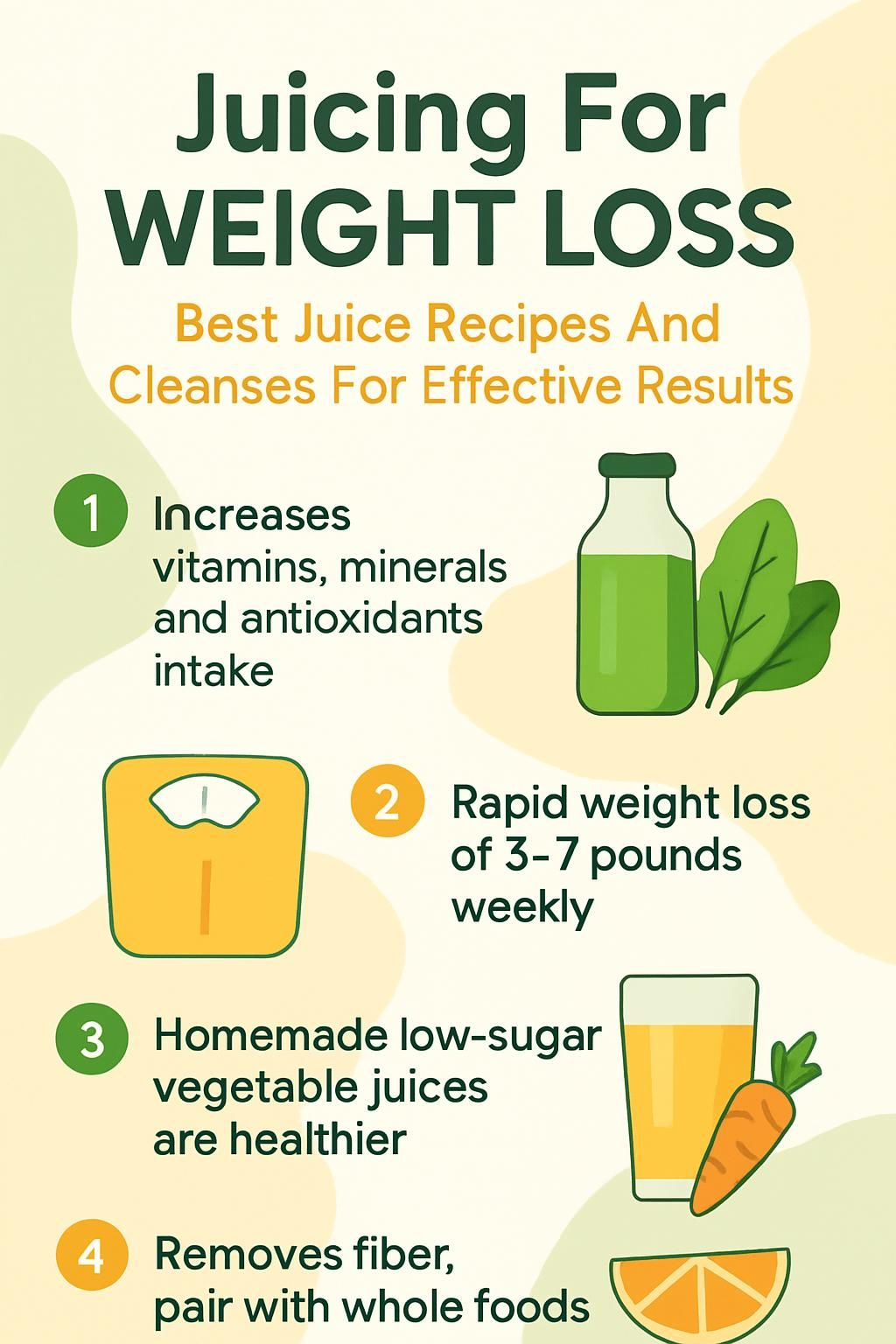Juicing For Weight Loss: Best Juice Recipes And Cleanses For Effective Results
Our Nutrition Assistant AI Suite will transform your body. You will lose fat, get toned, and build muscle. Gain confidence and optimal health.
Feeling stuck with slow progress on the scale? Juicing for weight loss can help cut calories while raising your intake of vitamins, minerals, and antioxidants.
This guide explains the benefits of juicing, how juice cleanses work, and the best juice recipes for weight loss you can make at home. See which healthy juices fit your goals and your routine.
Key Takeaways
- Juicing can raise vitamin and mineral intake while lowering calories, which supports weight loss.
- Juice cleanses may drop 3 to 7 pounds in a week; much of that is water weight that often returns.
- Homemade, low-sugar blends with kale, spinach, cucumber, and celery beat store options that add sugars.
- Juicing removes most fiber; pairing juices with whole foods and exercise helps protect muscle and steady blood sugar.
- Only 1 in 10 Americans meets fruit and vegetable goals, according to the CDC; juicing can help close this gap.

What Is Juicing and How Is It Different from Blending?

Juicing separates the liquid from produce and leaves most fiber behind. Blending uses the whole fruit or vegetable, so the fiber stays in your drink.
What does juicing mean?
Juicing means extracting the liquid from fruits and vegetables while most pulp, skin, and fiber stay out of the glass. A juicer splits juice from solids, giving you a drink high in vitamins, minerals, and plant compounds called phytonutrients. Fiber is low because it gets removed.
This creates a concentrated source of nutrients and natural sugars in liquid form. A green juice with kale, cucumber, and apple delivers vitamins A and C, potassium, and antioxidants without the bulk of whole produce.
“Juicing is a way to maximize nutrient intake from fruit and vegetable sources in a quick, easy-to-drink form.”
Many people include juicing in a juice diet for weight management or to support their body’s natural cleanup systems. It can make meeting your daily produce goals easier. Since fiber is limited, some people digest juice well, while others feel better with more fiber.
How does juicing differ from blending?
Juicing uses a machine to separate liquid from pulp; you get vitamins and minerals with very little fiber. Blending crushes whole produce into one thick drink, so you consume the juice and the fiber.
The difference shows up in fullness and blood sugar. Juices deliver quick nutrients like vitamin C and beta-carotene; smoothies digest slower because fiber helps slow sugar absorption and improves satiety.
For example, celery juice is clear and light from a juicer. A blended celery smoothie is thicker because it retains plant fibers.
I feel hungrier after a pure pressed veggie juice than after a breakfast smoothie. Energy spikes faster with juice, but smoothies last longer since the fiber stays put. Dietitians often suggest blending if you want steady blood sugar or need help with digestion.
Next, see how nutrient-dense, low-calorie juices can support weight loss goals without feeling deprived.
How Can Juicing Help Me Lose Weight?
Juicing offers a fast way to boost your produce intake. Many people use it to support healthy eating habits and weight control.
How does juicing provide low-calorie, nutrient-dense options?
Juices built from leafy greens and low-sugar produce give you lots of vitamins for few calories. Leafy vegetables like spinach and kale bring vitamins A, K, and C with little energy cost.
Try cucumber, celery, lemon, or herbs for flavor without many carbs or sugars. A cup of kale has about 33 calories and is rich in vitamin K and vitamin C. These choices help you feel nourished without excess energy intake.
Swapping a daily snack for a homemade green juice with spinach and lemon curbed my cravings and kept me energized. Making juice at home also lets you limit added sugars compared with many store-bought bottles.
Can juicing help me eat more fruits and vegetables?
Yes. It is easier to drink a mix of carrots, kale, or beets than to chew through large portions. Juicing can help you reach daily targets that feel hard to meet with whole foods alone.
In 2017, the CDC reported that only one in ten Americans gets enough fruits and vegetables. Homemade juices can help bridge this gap and support better health. A short juice fast can expose you to new combos like kale, beet, and citrus.
These juicing recipes support your plan with a variety of vitamins and minerals. They fit well beside whole foods for a balanced approach.
How does juicing support hydration and digestion?
Many fruit and vegetable juices are over 90 percent water. Watermelon and cucumber are prime examples. Good hydration supports metabolism and helps regulate blood sugar levels.
Juice also delivers natural enzymes, which are proteins that speed up chemical reactions during digestion. A simple celery and lemon blend helped reduce my post-meal bloating.
Green juices supply plant compounds that feed friendly gut bacteria. Healthier gut flora can improve nutrient absorption and ease constipation, especially if you return some pulp to your drink.
What Are the Benefits of Juicing for Weight Loss?
Used wisely, juicing can lower calorie intake, raise nutrient density, and support fat loss. The right juice recipes for weight loss help you stick with a healthy plan.
How does juicing promote fat loss with fewer calories?
Fresh juices can replace sugary drinks and processed snacks. Many green or veggie-based juices land under 100 calories per serving. This swap creates a calorie deficit, which supports fat loss, including belly fat.
Guidance from the Mayo Clinic and the Academy of Nutrition and Dietetics notes that calorie control is central to weight management. In my day, replacing an afternoon sweet drink with kale and cucumber juice cut calories and tamed cravings.
Better hydration may also lower feelings of hunger. That makes it easier to maintain a steady calorie target.
What essential vitamins and minerals does juicing provide?
Juicing can supply core micronutrients:
- Vitamin C from citrus and berries for immune support
- Vitamin K and iron from leafy greens for blood and bone health
- Beta-carotene from carrots for eye and skin health
- Potassium from greens and melon for heart health
- Folate and magnesium from greens for energy use and nerves
- Nitrates from beets and pomegranate that may aid blood pressure
Colorful blends also deliver antioxidants that protect cells from damage. People following a plant-forward diet often use juicing to fill nutrient gaps while keeping calories in check.
Can juicing reduce processed food intake?
Yes. A fresh fruit or vegetable juice can replace packaged snacks and sweet drinks. Over time, your taste can shift toward simpler, less sugary flavors.
More produce can mean fewer added sugars and unhealthy fats. That change supports weight control and better health. Many people find cravings fade after a few days of consistent juicing.
How can juicing improve gut health and reduce inflammation?
Vegetables and berries add antioxidants and polyphenols, which may calm inflammation. These nutrients also help the lining of your gut function well.
Some blends seem helpful for inflammatory markers. Beets and turmeric, for example, contain compounds that may help the body’s response to swelling. People with risk factors like type 2 diabetes or heart disease may benefit from an anti-inflammatory eating plan that includes low-sugar juices.
What Should I Consider Before Starting Juicing?
Juicing affects calorie intake, digestion, and daily energy. A little planning goes a long way. Speak with a health care professional if you have a medical condition or take medication.
Are juice cleanses effective for short-term weight loss?
Juice cleanses can cause quick weight changes because they reduce calories and carbs. Most early losses come from water and some muscle, not only fat. Many people see 3 to 7 pounds down in a week, then regain part of it afterward.
These plans are often low in protein and whole grains, which your body needs to protect muscle. High-fruit cleanses can also spike blood sugar. For short-term results, a cleanse may help, yet it is not a long-term solution for health.
Check with a clinician before doing a cleanse, especially if you have kidney, heart, or blood sugar issues.
What is the role of fiber in digestion and feeling full?
Fiber keeps your gut moving and promotes regularity. It also slows digestion, which helps you feel full longer and can support weight loss.
Whole fruits and vegetables beat juice on fiber. During one cleanse, I felt hungrier than when I ate whole foods. Higher fiber intake is linked with better gut health and a lower risk of several chronic conditions.
Fiber can also help control blood sugar and may reduce long-term cancer risk. For sustainable weight control, do not leave fiber behind.
Why should I avoid high-sugar fruit juices?
High-sugar juices drive blood sugar up fast. That spike often leads to crashes, hunger, and extra calories later. Many bottled juices pack over 20 grams of sugar per cup, similar to soda.
Processing also strips out most pulp, which reduces fullness. My best results came from veggie-heavy blends with a small piece of fruit for flavor. Cucumber, celery, spinach, or lemon are strong low-sugar picks.
How important is combining juicing with a balanced diet and exercise?
Very important. Juice alone cannot supply enough protein, fiber, or healthy fats for lasting weight loss. People who pair juices with whole foods and regular activity keep results longer.
Balanced meals protect muscle and support steady energy. Exercise helps burn fat and keeps metabolism active while you eat fewer calories. Think of juice as a helpful add-on to a solid meal plan and movement routine.
What Are the Best Practices for Juicing to Lose Weight?
A few simple habits make juicing more effective and easier to stick with.
Why prioritize low-calorie, high-fiber vegetables?
Low-calorie, fiber-rich vegetables fill you up without adding many calories. Kale, spinach, cucumber, and celery are top choices that deliver vitamins and minerals for very few calories.
Fiber slows digestion and steadies blood sugar. Research links higher fiber intake with fewer cravings and better weight outcomes. Juices built on these vegetables help you skip processed snacks and limit high-sugar fruit mixes.
How much fruit should I use for flavor?
Use a small serving of fruit per glass. Green apple, orange, lemon, or berries add taste and nutrients with less sugar than tropical fruits.
Keeping fruit near one-third of the blend helps manage calories and blood sugar. Pair the fruit with greens like spinach or kale to improve fullness and support steady progress.
Should juice replace meals or be part of them?
Use juice as part of meals rather than a meal replacement. Most juices lack enough protein, healthy fats, and fiber to keep you full and strong.
Replacing every meal with juice can speed short-term weight loss, but it also risks muscle loss and a slower metabolism. Many experts suggest adding juice to a balanced eating plan instead of long cleanses.
How can blending or adding pulp help retain fiber?
Blending keeps all the parts of the produce, including the pulp that holds fiber. Both soluble and insoluble fiber help steady blood sugar and support gut health.
Stirring some pulp back into strained juice makes the drink more filling. For example, blended oranges provide more fiber than strained orange juice. That extra fiber can smooth energy and reduce cravings.
Types of Juices That Support Weight Loss
You have many options that help you lose weight while getting key nutrients. Focus on low-sugar vegetables and use fruit lightly for flavor.
What are green juices?
Green juices feature greens like kale, spinach, cucumber, and celery. A small squeeze of lemon or a bit of apple adds brightness without much sugar.
They are low in calories and high in vitamins and minerals that support health. Dietitians often recommend them because they deliver vitamin C, vitamin K, folate, potassium, and antioxidants that aid your body’s natural cleanup systems.
What are detox juices?
Detox juices combine produce that supports your body’s normal filtering and removal processes. Common choices include lemon, celery, apple, and ginger. These blends are usually low in calories and sugar when vegetables are the base.
You may notice better hydration and lighter digestion. I tried a five-day plan one spring and felt less bloated. Always listen to your body and keep the focus on vegetables.
Which low-sugar fruit and vegetable combinations are best?
Pair leafy greens with low-sugar fruits for balanced flavor and fewer calories. Try these ideas:
- Spinach plus cucumber with half a green apple
- Kale with lemon and a few berries
- Celery with lemon and a small slice of pear
These mixes keep sugar lower than blends with pineapple or mango. You still get bright flavor and strong nutrition.
What Are the Top 7 Juice Recipes for Weight Loss?
Use these practical recipes to build a routine you can maintain. Each one favors vegetables and light fruit for taste.
How do I make Green Juice with Kale and Cucumber?
Wash and chop four kale leaves, one medium cucumber, and one green apple. Run them through your juicer with half a lemon and a small piece of ginger. The result is low in calories and rich in vitamins A, C, and K.
This green juice supports weight loss by cutting calories and adding hydration. If you want more body, blend or stir a bit of pulp back in.
What is the recipe for Carrot and Ginger Juice?
Gather 4 medium carrots, a 1-inch piece of fresh ginger, half a lemon, and 1 cup cold water. Peel and chop the carrots and ginger. Squeeze the lemon. Blend everything until smooth, then strain through a fine sieve or cheesecloth.
Carrots bring vitamin A and gentle sweetness. Ginger can help with digestion. I like this one in the morning because it curbs sugar cravings and feels refreshing.
How to prepare Apple and Kale Juice?
Use one large apple, a handful of kale, and half a lemon. Wash well, remove tough kale stems, and quarter the apple. Juice the kale and apple, then squeeze in the lemon.
The apple adds mild sweetness while kale supplies vitamin K and vitamin C. Even picky eaters tend to enjoy this balance.
What are the ingredients for Beetroot and Berry Juice?
Use one small raw beet, one cup mixed berries, one medium apple, half a lemon, and one cup cold water. Add a few mint leaves if you like.
This blend offers antioxidants and fiber from berries and beets with controlled sugar. It fits well in a low-calorie plan.
How do I make Lemon and Spinach Juice?
Wash one cup spinach and half a lemon. Juice the spinach with half a peeled cucumber for more water. Squeeze in the lemon. Add a small green apple if you prefer a touch of sweetness.
Drink soon after making to capture vitamin C and iron. This crisp mix supports hydration and can help you feel light.
What is Celery and Lemon Detox Juice?
Slice four celery stalks and juice with the juice of half a lemon. Add filtered water to taste. If you include some pulp, you will keep nearly 2 grams of fiber in a small serving.
This simple blend is low in sugar and high in water. Vitamin C from lemon and potassium from celery make it a smart, light choice that many people use to ease bloating.
How do I prepare Watermelon and Mint Juice?
Cube two cups of ripe watermelon and remove seeds. Blend with ten mint leaves and half a cup of cold water. Strain if you want a lighter texture, then pour over ice.
Watermelon hydrates with few calories, and mint adds flavor without sugar. I often use this after a workout to cool down without reaching for sweet drinks.
What Are the Pros and Cons of Juice Cleanses?
Juice cleanses can bring fast changes, yet effects differ between people. Consider short-term benefits alongside possible downsides.
What temporary benefits do juice cleanses offer?
Quick losses often appear on the scale because your body uses stored glycogen. Glycogen holds water, so you shed water weight as it drops.
People often feel less bloated and more hydrated. Higher intake of vitamins and minerals for a few days may feel energizing. I noticed clearer skin and lighter digestion during a brief cleanse.
These gains are usually short-lived. Without healthy habits after the cleanse, weight and energy often return to baseline.
What are the risks of muscle loss and slowed metabolism?
Extended low-calorie plans with too little protein can cost you muscle. Less muscle can slow your metabolism, which makes weight regain more likely. Some adults may lose meaningful muscle during long fasts or very low-calorie periods.
To protect your muscle, include protein in your meal plan and keep up regular exercise. Most professionals favor gradual, balanced changes over strict cleanses.
How Can I Use Juicing for Sustainable Weight Loss?
Juicing works best as part of a healthy lifestyle. Combine it with balanced meals, steady activity, and realistic goals.
Why combine juicing with a whole-food diet?
Juice offers quick vitamins and minerals for few calories. Whole foods supply fiber, protein, and healthy fats that keep you full and protect muscle.
Meals built from vegetables, beans, lean meats, nuts, and whole grains help prevent blood sugar spikes that come with sweet juices. Many people see better results by adding juice to daily meals rather than skipping solid food.
How to follow a long-term healthy eating and exercise plan?
Set clear, realistic targets and track both food and movement. Use low-calorie, nutrient-dense juices to raise produce intake while staying within your calorie goal. Replace processed foods with simple, whole choices.
Plan meals with protein, complex carbs, healthy fats, and colorful produce. Limit alcohol because it adds empty calories. I made morning walks a daily habit, which kept me consistent for months.
How to monitor calorie intake and avoid over-reliance on juice?
Track juice calories with a label or a mobile app. Count everything you add. Natural sugars still add up.
Balance juice with whole foods to get enough fiber and protein. A solid breakfast with eggs or oats kept me satisfied and reduced the urge to sip extra juice. Aim for one small glass per day and rely on whole produce for the rest.
Frequently Asked Questions about Juicing
Here are straight answers to common questions on safety, frequency, and how to fit juice into your day.
Can juicing replace meals?
Not on a regular basis. Fresh juice usually lacks enough protein, healthy fats, and fiber. Those nutrients support weight control and energy.
Juice-only plans can cause fatigue, muscle loss, and nutrient gaps. The Academy of Nutrition and Dietetics notes that low-energy plans can slow your metabolism. Use juice as a supplement to balanced meals for better long-term results.
Is juicing safe for people with diabetes?
It can be tricky. Many fruit juices are high in natural sugars and can raise blood sugar quickly because they lack fiber. Choose non-starchy, low-sugar vegetables like kale, spinach, celery, and cucumber.
Avoid very sweet fruits, monitor your readings after juicing, and talk with your health care provider before making big changes to your diet.
How often should I juice for weight loss?
Many people do well with one small vegetable-based juice once or twice per day, alongside balanced meals. A morning juice or an afternoon snack can reduce cravings for processed items.
Pick low-calorie, low-sugar blends and keep whole foods on your plate. Track your progress and adjust based on your energy, hunger, and goals.
Conclusion
Used smartly, juicing for weight loss can help you eat more produce, cut calories, and still get key vitamins and minerals. Low-sugar, veggie-first recipes support steady progress without huge swings in energy or hunger.
Juice cleanses may deliver quick changes, but lasting results come from pairing juices with a balanced diet and regular exercise. If you have a medical condition, speak with a health professional before starting a cleanse or major diet shift.
Choose simple recipes, stay hydrated, and let consistent habits do the heavy lifting. That is how juicing supports healthy, sustainable weight loss.
FAQs
1. What are the benefits of juicing for weight loss and overall health?
Juicing can help with weight loss by reducing calorie intake while providing vitamins and minerals that support overall health. Studies show that consuming more fruits and vegetables may improve digestion, boost energy, and aid in fat reduction.
2. Which juice recipes work best for weight loss and improving overall health?
Green juices made from spinach, cucumber, celery, apple, and lemon are popular choices. These juices are low in calories but high in nutrients, which supports both weight loss and overall well-being.
3. Are juice cleanses safe for long-term weight management and overall health?
Short-term juice cleanses may lead to quick weight loss; however, evidence suggests they should not replace balanced meals over time. For lasting results in weight loss and overall health, combine juices with whole foods as part of a healthy diet.
4. How does personal experience support the effectiveness of juicing for weight loss and better overall health?
Many people report feeling lighter, more energetic, and healthier after adding fresh juices to their routines. For example, after following a three-day green juice plan alongside regular meals, I noticed improved digestion and steady weight loss without feeling deprived.
Summary: Juicing offers a practical way to support weight loss and enhance overall health when used with a balanced diet. Choose nutrient-rich recipes, use cleanses wisely, and pay attention to your body’s response to achieve effective results.







